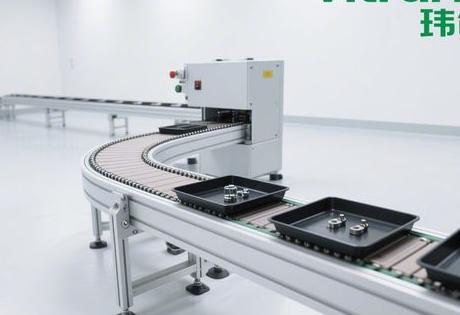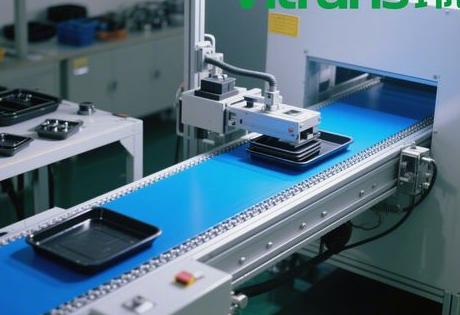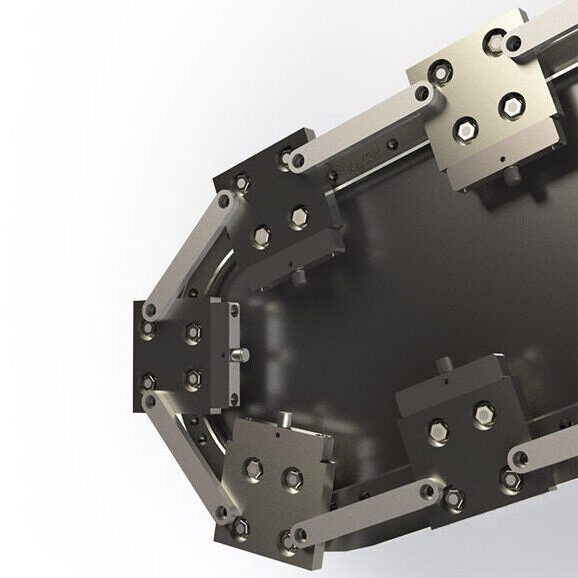I. Principle of differential transmission: precise coupling of physical efficiency and lithium battery production
The core requirements for conveyor systems in lithium battery production are"Fast and slow."--Both 2-3 times the speed to transport 30kg battery case, and millimetre precision control in the welding, liquid injection and other key aspects. Its physical basis lies in the differential sprocket structure:

- velocity stacking effect: The ratio of roller diameter (D) to roller diameter (d) (D=2.5d~3d) makes the speed of the work plateV = V₁ × (1 + D/d), with a theoretical growth rate of up to three times;
- Friction loss compensation: In practice, the chain friction causes the speed increase to decay 5%-8%, which needs to be reserved for the dynamic margin in the CAD design;
- Shift Control Breakthrough: Dual-motor drive system realises switching between the high-speed section (1.2m/s) and the welding low-speed section (0.15m/s), with a transition time of ≤0.3 seconds, and the alignment accuracy is improved to ±0.5mm.
Second, the five core modules: from efficient transport to explosion-proof safety synergistic evolution
1.Transmission Power Module: "Nerve Centre" for Fast and Slow Switching
- Magnetic Levitation Deskew Technology: When the offset exceeds 1mm, the electromagnetic array automatically reverses the correction, avoiding the pallet jamming and triggering the whole line downtime;
- Distributed servo drives: 5G TSN network (latency <1ms) coordinates multiple motors with phase synchronisation accuracy ±0.3°.
2.High-precision assembly modules: the art of building blocks at the micron level
- Six-axis vision robot: 3D camera + force control sensor, 0.8 seconds to complete the core grabbing - flip - insertion, force control 5N ± 0.3N (pinch the egg does not break the precision);
- Laser cleaning station2000W pulsed laser instead of sandpaper grinding, 0.2 seconds gasification of the oxide layer of the pole column, 5 times higher efficiency and no dust pollution.
3.Explosion-proof Safety Module: "Fireproof Armour" for Production Lines
- Inert gas curtain systemsLiquid injection station nitrogen infusion to make the oxygen concentration <5% (below the detonation threshold of 12%), BYD blade battery production line for 3 years zero accident;
- Static dissipative chains: Conductive engineering plastic chain links, surface resistance 10⁴-10⁶Ω, 1 second to conduct away 2000V static electricity, eliminating the risk of diaphragm breakdown.
4.In-line detection module: 30 "CT scans" per second
- X-Ray + infrared dual detection system: Fluoroscopic pole piece alignment + scanning surface temperature difference (>2℃ is alarmed), defect detection rate 99.97%;
- AI Coating Analyser: Compare 12 parameters of diaphragm coating within 50ms and adjust the coating head pressure in real time.
5.Flexible Changeover Module: Switching Product Models in Half an Hour
- Quick release pallet systemDovetail groove structure enables 10 seconds replacement of square/cylindrical/soft pack battery trays with ±0.1mm positioning accuracy;
- Memory Tightening Gun: Torque is automatically adjusted from 8N-m to 15N-m when switching from a 60kW-h to a 100kW-h battery pack.
Personal opinion: current explosion-proof design overly relies on gas infusion, which needs to be developed in the futureVacuum-sealed chamber + ceramic matrix composite chain-Zirconia ceramics at 400 ℃ strength retention rate of more than 90%, with the vacuum environment can be eliminated from the source of combustion and explosion conditions, to achieve intrinsic safety.

III. Structural innovation: double breakthrough in heavy load and intelligence
▎ Revolution in Materials and Loads
- Carbon Steel Bearing Roller: Increased single pallet load from 150kg to 250kg to support welding of 500kg battery packs;
- High temperature resistant nylon chain: Adapts to 150°C environment in the welding line and extends the life by 3 times.
▎ Space and Redundant Designs
- 3-5 metre extension area reserved: Support for future addition of inspection stations (e.g. vacuum sealed chambers for solid state batteries);
- Oversize Motor Selection: The current load of 1800kg is configured according to the standard of 2200kg, avoiding the replacement of core components when the capacity is increased.
▎ Digital twin previews
- SolidWorks models directly connected to PLCs: Trial and error costs for production line layout changes reduced by 651 TP3T and virtual debugging cycle time shortened by 701 TP3T.
Fourth, the production process: from design to load test precision closed loop
- Requirements analysis phase: Conveyor speed, load profile, and explosion-proof rating are determined according to the battery type (square/cylindrical/soft pack);
- Structural manufacturing phase::
- Rack laser cutting accuracy ±0.05mm;
- Sprocket tooth surface carburising quenching hardness HRC58-62;
- Intelligent Integration Stage::
- The magnetic levitation guide is embedded with the AI detection module;
- Nitrogen curtain nozzle spacing ≤ 10cm;
- Load Test Verification::
- The 250% overload running test lasted 2 hours;
- Sudden temperature change test (-20°C → 80°C) to check the thermal deformation compensation performance.
Exclusive Data Insight
Global Lithium Battery Multiplier Chain Market Size to Surpass $62 Billion by 2030, but faced with two major contradictions:
- cost dilemma: Explosion-proof chains are available at a unit price of up to120/Metre (plain chain)45), SME production line modification costs over $500k/km;
- technology gap: The head enterprise adopts AI vision alignment + laser cleaning with a yield of 99.97%, while small and medium-sized factories still rely on manual inspection (yield ≤95%).
The path to a solutionconsist inModular Rental Ecology(e.g. Wei Chuang LK-HT model monthly rental $280/m) - A small factory in Zhejiang took this opportunity to increase the automation rate from 15% to 68%, and the single-line production capacity increased by 1,60%.
Self-questioning: Cracking the focus of industrial landing controversy
Q1: Why is the doubler chain more suitable for lithium battery production than belt line?
The double advantage of intrinsic safety and precision::
- The belt line is resistant to an upper temperature limit of 80°C, while the stainless steel frame + nylon chain of the Speed Chain is resistant to 150°C welding heat;
- The belt line has a load limit of 500kg and is easy to slip, the double chain structure of the speed chain can stably transport 2000kg battery packs, and the magnetic levitation guiding ensures ±0.5mm positioning.
Q2: How to solve the risk of battery box dumping in corners?
Third-order mechanical control system::
- Centrifugal force simulation prediction: SolidWorks Motion calculates guideway inclination versus velocity correlation curves;
- Roll Density Dynamic Encryption: 10% increase in the number of chain links in the curved section and 15% increase in roller density;
- Real-time electromagnetic correction: Laser sensor detects offset → triggers reverse adsorption of the damper within 0.1 sec.
Q3: How can SMEs apply high-end multiplier chains at low cost?
Fourth-order leapfrog path::
- transitional phase: Rental of shared production line ($280/month-metre), with only high-risk sections such as welding and fluid injection modified;
- formative years: Open source IoT system (Raspberry Pi + infrared sensor) to build the console, cost <$2,000;
- expansion period: Procurement of high temperature resistant nylon chain section ($45/m) to partially replace metal chain, cost reduction of 30%;
- maturity: Digital twin platform previews production line iterations with 40% ROI improvement.
(Technical parameters and cases synthesised from industry chain engineering verification)













